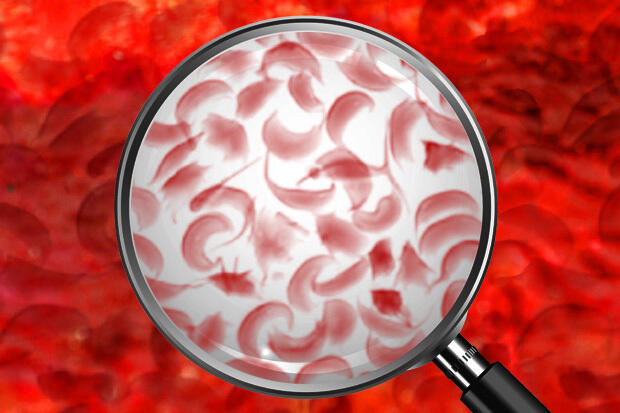
April 13, 2015
Singling out sickle cell
Share this story
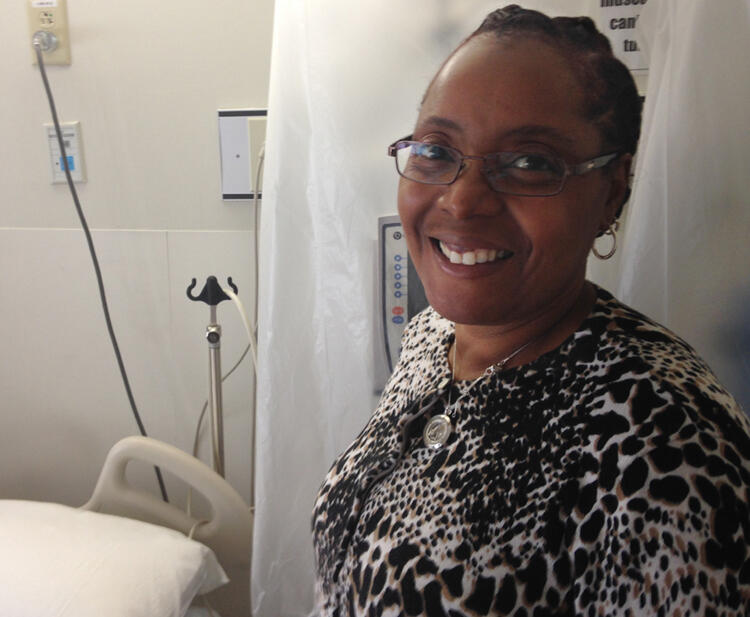
Much of Mary Madu’s job is about offering purpose to the lives of sick people who have given up hope.
“You can make a difference,” she often tells them. “You can actually change this world.”
Madu is an advanced research coordinator in the Center for Clinical and Translational Research at Virginia Commonwealth University. She spends her days at VCU Medical Center recruiting for and administering clinical trials related to sickle cell disease.
Sickle cell disease is a disorder that can lead to serious, sometimes life-threatening symptoms including severe pain, stroke, low oxygen levels and cumulative damage to tissues and organs. More than 100,000 people of all ages in the United States are afflicted with the disease.
“What I hope to see is the sickle cell population step up to the plate,” said Madu. “To not just sit by and let others do it. There is little hope for future generations of children with sickle cell without this population’s help.”
Those who choose to participate in the clinical trials at VCU help test the effectiveness of compounds and therapies that ultimately can reduce suffering around the world. One such compound is Aes-103, and Madu and her clinical trial participants hope to soon help examine it, thus playing an important role in the drug’s journey from bench to bedside.
After completing clinical trials, Aes-103 could become only the second approved drug in the world that is therapeutically effective in managing adult sickle cell disease. It would be the first in the world to work by targeting hemoglobin.
The trial will take place at numerous sites across the country, but Madu, the potential VCU trial participants and many others from across VCU will be able to claim a unique distinction among those sites should VCU be selected: They will get to call Aes-103 one of their own.
The discovery: Like a dog with a bone in his mouth
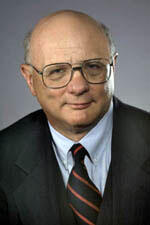
Aes-103 was conceived and cultivated at VCU through decades of interdisciplinary research and development.
Early studies indicate the compound may work by binding to and stabilizing the relaxed state of hemoglobin and increasing oxygen affinity and stabilization, thereby reducing the sickling of red blood cells, which, in turn, may reduce sickling-related outcomes.
Donald Abraham, Ph.D., now Alfred and Frances P. Burger Emeritus Professor of Medicinal Chemistry and Biological Chemistry at VCU, was the driving force behind the process.
He often quotes Paul Ehrlich, a 1908 Nobel Prize winner in medicine, who said scientists always need the four German Gs to find success. They are Geschick (skill), Geduld (patience), Glück (luck) and Geld (money).
He said all four Gs were necessary in the Aes-103 journey.
Skill
What’s important at VCU is not only that the skill exists to produce magnificent discoveries, but that there is an environment conducive to interdisciplinary fusion of that skill.
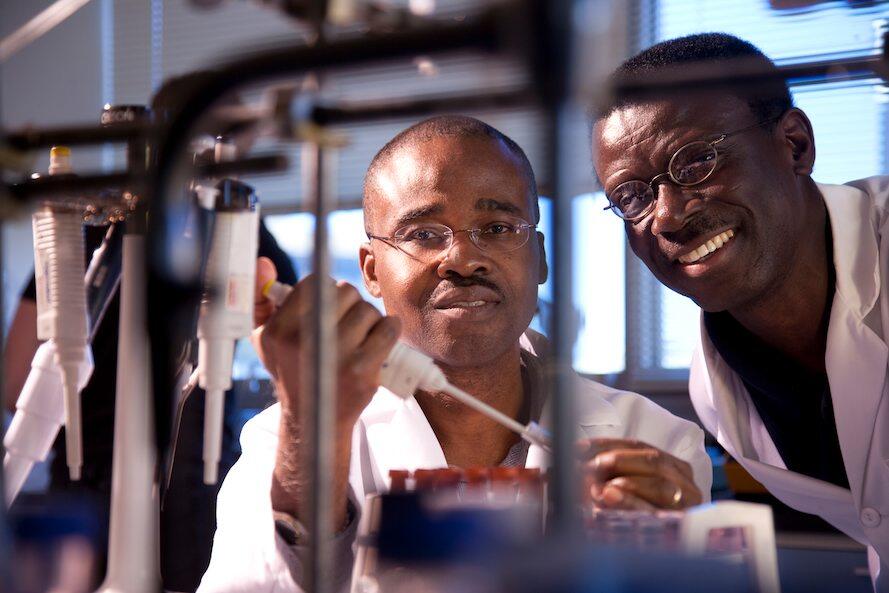
Aes-103, originally patented by VCU under the name 5-HMF, was developed at the VCU Institute for Structural Biology and Drug Discovery, a research center spanning the VCU School of Medicine and the VCU School of Pharmacy. Abraham worked there alongside Martin Safo, Ph.D., and Richmond Danso-Danquah, Ph.D., on what would become the patented compound.
“The discovery and translation of Aes-103 reflects the promise and power of interdisciplinary research,” said Frank Macrina, Ph.D., vice president for research and innovation at VCU. “Its discovery and development is the result of teamwork that spans natural product chemistry, medicinal chemistry, pharmaceutics, toxicology, structural biology and clinical testing.”
Patience
Abraham arrived at VCU in 1988 as chair of the Department of Medicinal Chemistry armed with a drive to find a treatment for people with sickle cell disease. At the time, there were no treatments, and little attention was paid to the disease.
He said the lack of attention neither motivated nor deterred his work; instead, what fueled it “was a passion, and that passion infused perseverance.”
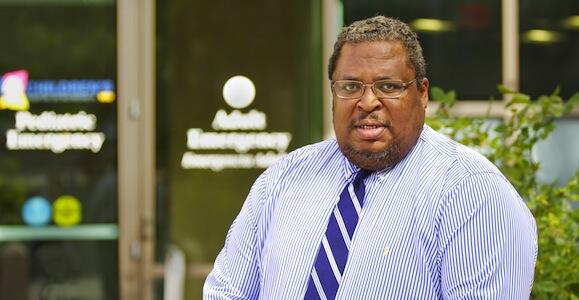
“The development of Aes-103 is a testament to the Edison-like qualities of Dr. Abraham,” said Wally Smith, M.D., professor in the VCU School of Medicine, scientific director of the VCU Center on Health Disparities and prominent sickle cell treatment researcher. “Edison is famous for having tried hundreds of different types of filaments to try to find the light bulb, and Don’s work is like that.”
Abraham knew a small molecule would be necessary, but it needed to be nontoxic, as it would travel with the blood to every part of the body. He pored over thousands of possibilities through the years before finding the right molecule.
While Abraham identifies his process as an example of patience and perseverance, his wife uses other terms.
“My wife has often told me I am like a dog with a bone in his mouth,” he said. “It is a common disease among those who fall in love with their profession.”
Luck
Eventually, that perfect nontoxic molecule Abraham sought came along.
“Along the way we had discovered a number of organic molecules that were very effective in the test tube, but were either toxic to red blood cells or to humans in the doses needed to treat the disease,” he said. “Aes-103 actually arose from a train ride my wife and I were taking from Rome to the University of Parma, where I was a visiting professor. We shared a cabin with a British food chemist. I told him we were interested in trying to find a nontoxic food additive that might be used to treat sickle cell anemia. He sent me a list of molecules, and that led us to 5-HMF. Luck and serendipity!”
Money
Abraham credits much of his success to the VCU resources that helped launch the Virginia BioTechnology Research Park, which was incorporated in May 1992 as a joint initiative of VCU, the city of Richmond and the commonwealth of Virginia.
Today the BioTech Park is home to 57 private and nonprofit companies, state and federal laboratories, and research institutes/administrative functions of VCU and the VCU Health System, employing approximately 2,400 researchers, scientists, engineers and support personnel.
VCU Innovation Gateway, which calls the BioTech Park home, is a university resource that facilitates commercialization of university inventions and supports research through collaborative agreements. It was an essential component in moving Aes-103 to market and ultimately to being acquired by Baxter International, a global health care company with expertise in medical devices, pharmaceuticals and biotechnology.
The Baxter acquisition means advanced clinical trials will take many fewer years to complete, thus drastically reducing the time it will take for Aes-103 to reach patients.
The vessel: Translational research
The conceptualization, development, application and even the commercialization of Aes-103 are all examples of translational research in progress.
Translational research focuses on multidisciplinary collaboration that accelerates laboratory discoveries into treatments for patients. The first phase of translation is from laboratory findings to clinical practice. The second phase enhances the adoption of these clinical best practices in the community.
As the National Institutes of Health has made translational research a priority, VCU – through the National Center for Advancing Translational Sciences program – is one of 62 institutions across the nation entrusted with shepherding this research.
“It is a tremendous responsibility and opportunity to be a leader in translational research,” said F. Gerard Moeller, director of the CCTR and associate vice president for clinical research at VCU. “Over the five years the VCU CCTR has been funded, it has helped guide products, researchers and treatments across the divide that lies between the bench and the bedside, and then across the equally difficult divide that is institution to community.”
The CCTR provides the necessary infrastructure and resources for interdisciplinary human health research within VCU and among its peer institutions. It acts as an academic bridge from home departments and schools via networking, training and services such as bioinformatics assistance.
Projects the CCTR has helped facilitate and/or is still involved with include a 2014 $6 million grant to develop a center for identification, evaluation and development of treatments for cocaine addiction; an $18.1 million grant to study novel tobacco products such as electronic cigarettes; a grant from Pfizer to support the Virginia Women’s Stroke Prevention Initiative focused on prevention in underserved women; a $5.57 million dollar grant from the U.S. Army to study the effects on patient bleeding and survival when plasma is administered more quickly in trauma cases; and the development of a bandage that uses proteins to stop bleeding almost instantaneously.
The CCTR also supports Engaging Richmond, a partnership between community members and VCU researchers based in Richmond’s East End. Since the project’s inception in 2011, members of the Engaging Richmond team have used mixed methods research to explore the social and environmental factors that influence health.
“Aes-103 in particular has been very fortunate to have the support of the CCTR and other federal start-up programs that help struggling companies at universities get a leg up and develop drugs,” Smith said.
The Participants: Something larger than themselves
The opportunity to be a part of translational research gives Mary Madu’s patients and participants a new sense of purpose, something many of them have lost, she said.
“I find that what is lacking in this population is taking pride in who they are and being content with who they are,” she said. “Once that is instilled in them through being a part of something, it all changes.”
A successful phase I clinical trial of Aes-103 was completed last year at the NIH. Next, Aes-103 will go through a two-part phase II trial, which is currently recruiting participants.
“VCU is hoping to be one of many sites asked to enter patients into the phase II trial,” Smith said. “I would be enthusiastic to enter patients if VCU is selected since the drug was developed here."
Madu cites multiple patients who were, on first acquaintance, wrought with low self-confidence and doubt, but after becoming participants in clinical trials became positive people who are often now the ones who encourage her to “liven up.”
It comes down to those participants being a part of something larger than themselves; in the case of Aes-103, that something is a translational research path that started on VCU’s lab benches almost 30 years ago, is continuing today in clinical trials and will hopefully soon find its home at hospital bedsides across the world.
Subscribe for free to the weekly VCU News email newsletter at http://newsletter.news.vcu.edu/and receive a selection of stories, videos, photos, news clips and event listings in your inbox every Thursday. VCU students, faculty and staff automatically receive the newsletter. To learn more about research taking place at VCU, subscribe to its research blog, Across the Spectrum at http://www.spectrum.vcu.edu/
Subscribe to VCU News
Subscribe to VCU News at newsletter.vcu.edu and receive a selection of stories, videos, photos, news clips and event listings in your inbox.










